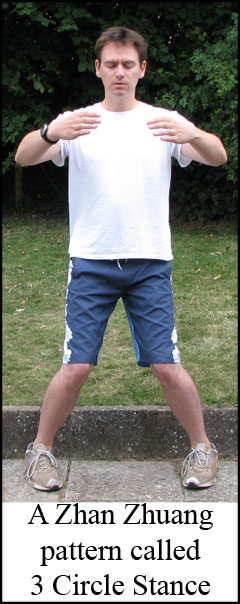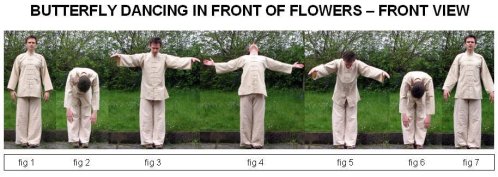Let’s get one thing out in the open before we begin. I’m obviously biased. I’ve been practicing Qigong for well over a decade, I’ve been teaching it since 2004, I’m an author of a book on Qigong, I was the chief instructor in the UK of a world wide institute that teaches Qigong, I’m the creator of the Qigong Secrets 22 week home study course available via the Internet and founder of the Qigong15 blog — dedicated to the spread of ‘fluff free’ qigong goodness.
In my defense I first began practicing Tai Chi whist at University between 90-93, I practiced it again between 1995 and 2000 with the Wutan school whilst living in Nottingham. I was in the process of being taught how to teach Tai Chi for Wutan when I found Grandmaster Wong Kiew Kit and made the very difficult decision to leave Wutan and begin my training with the Shaolin Wahnam Institute (founded by Grandmaster Wong Kiew Kit).
Over the next 9 years whilst practicing Shaolin Kung Fu and Shaolin Qigong I had a number of opportunities to attend special ‘invitation only’ combined Tai Chi Chuan and Shaolin Kung Fu intensives. And can testify to the incredible combat efficiency of Tai Chi Chuan when it is practiced as a martial art and not as Grandmaster Wong Kiew Kit calls it: ‘Tai Chi dance’.
I share this information with you, not to brag, but in the desire to demonstrate that I know what I’m talking about when discussing Tai Chi and Qigong.
The next confession I’d like to make is that if you are practicing Tai Chi Chuan as a martial art and you enjoy practicing it as a martial art then you probably shouldn’t waste your time reading the rest of this article.
But if you are practicing Tai Chi primarily to gain it’s health and vitality benefits then I’m going to spend the next 1712 words explaining why your time and energy is better invested in Qigong than Tai Chi.
With that in mind, let’s get started.
Why do people practice Tai Chi? Let’s have a look at some of the main reasons:
- To improve physical health
- To reduce the negative effects of stress
- To live a long, active life
- Spiritual cultivation
Let me quickly give you an explanation of what qigong is, though if you’re a Tai Chi practitioner, I’m confident you will have heard of it.
Qigong is the art of deliberately working with your bodies vital energy (qi/chi/ki). (Most) Qigong is a composite of slow external moves co-ordinated with the breathing, performed in a meditative state of mind. What does that sound like? Tai Chi?
Why do people practice Qigong? There are 5 main reasons:
- To improve health and increase energy/vitality
- To increase Longevity
- To develop internal force (think of it as energy+ usually favoured by martial artists)
- To improve mental clarity
- For Spiritual cultivation.
Again, that list looks pretty similar to the one which looked at the main reasons why people, you included, practice Tai Chi.

In my opinion the only significant reason you would practice Tai Chi instead of Qigong is if you are practicing it as a martial art. Now Qigong will be useful for you as a martial artist in developing internal force. I’d even go on a limb and say that if you practice Tai Chi for martial reasons then you’ll be very familiar with the Zhan Zhuang exercise known as ‘Three Circle Stance’.
Assuming though that you are still reading this article because you practice Tai Chi mainly for health benefits then I’d like to tell you that Qigong is much easier to learn than Tai Chi.
Let me explain.
Q: How many patterns are there in the Tai Chi form your are learning? Probably anything from 24 to 108+ depending on what ‘style’ you are learning. How long did it take you, or how long is it taking you to, to learn all of these patterns and be able to move smoothly and flowingly from one to the other?
From my experience of having the opportunity to learn Yang (short and long form), Sun and Chen style I would have to say it takes months just to be able to remember what ‘move’ comes next.
Then it takes many more months to flow effortlessly from one pattern to the next. I remember taking many months to be able to move competently from Snake Creeps Down to Golden Cockerel Stands on One Leg.
So, even when you know which pattern comes next, being able to ‘flow’ there with good form, energy and mind can take an age to learn.
Then we get into ‘hardcore’ Tai Chi theory territory. The realms of Yin and Yang, avoiding being double Yang and Tai Chi philosophy. If you’re a practitioner of Tai Chi then you already know that Tai Chi is considered a Taoist art. And to be blunt, those Taoists can be deliberately confusing individuals!
I personally found that when I attempted to bring Tai Chi philosophy to my Tai Chi practice, I invariably ended up feeling confused, confused, confused. Oh, and often frustrated as well.
The material written in many books and spread by many teachers is just down right nonsense, usually interpreted incorrectly from ancient Taoist texts. Texts which were deliberately written in a way that assumed that you were a student, familiar with many of the esoteric terms, under the tutelage of a master and not just some dude with 20 bucks in your pocket wondering into Barnes & Noble.
In contrast, Shaolin Qigong philosophy is incredibly simple. It is based on the theory of Traditional Chinese Medicine. What follows is a very simple overview of Qigong:
Qi/Chi/Ki flows through the body along streams known as the meridians. Blockages to the smooth flow of qi through the meridians result in illness.
Qigong seeks first to clear these blockages, thus promoting smooth qi flow which results in good health. As we continue our practice of Qigong our qi flow becomes vigorous which results in good health and vitality. Eventually we have an abundance of qi flowing through the meridians and this results in good health, vitality and longevity. In short you live a happy, healthy and long life.
A Qigong exercise usually consists of an average of 5 or 6 ‘moves’ (see the diagram below):

Which means you can learn it so much quicker than Tai Chi and means therefore that you can start getting the benefits so much quicker as well.
Q: How long does it take you to do your Tai Chi practice? Now I realise this will vary wildly depending on how ‘serious’ you are. If you only practice when you go to class then you may only practice an hour a week. If this is you, then I hate to tell you this, but when it comes to achieving health and energy – you’re wasting your time.
Both Tai Chi and Qigong are not some 30 day miracle cure. Despite what some of the adverts would have you believe. No. If you want results, you must practice daily.
Now when I practiced Tai Chi, I used to practice a minimum of 30 minutes a day and attend classes 3 times a week.
So with Tai Chi, not only do you have the huge investment of time learning a form, but then you have to invest time practicing that form, so that you can co-oridinate your hands with your feet, your elbows with your knees and so on.
Well with Shaolin Qigong you need only practice for 15 minutes a day to get the 5 main benefits that I listed earlier. Not only do you save massive amounts of time by only having to learn the few ‘moves’ that make up the qigong exercise you’re practicing, but you only have to practice it for 15 minutes a day.
Trust me, Qigong practitioners make a substantial ‘Time’ saving compared with Tai Chi practitioners whilst getting health and energy benefits quicker. It’s a double result.
In fact the simplicity of Qigong in comparison to Tai Chi, means that Qigong practitioners can quickly focus on developing the 3 core skills of qigong. And remember it is skill that makes the difference between a beginner and an expert. It is skill that allows you to access the 5 main benefits of qigong and live a happy, healthy and long life.
Personally, I believe that time is one of the most precious and valuable ‘commodities’ that we possess. When it’s gone, it’s gone. What we do with our time dictates the results we get in our lives.
Finally I would go out on a limb and say that if you want to get the wonderful health and vitality benefits of Tai Chi (and don’t get me wrong, they really are wonderful if you have the time to get them and a good teacher to guide you) then you have to practice Tai Chi as a martial art or as Tai Chi Chuan (Taijiquan). Yet so very few people do.
When I first began learning Tai Chi at university I was rather confused. I had read that Tai Chi Chuan meant ‘Supreme Ultimate Fist’, I had read that it was a formidable ‘internal’ martial art. And yet I could not comprehend how the slow, gentle, graceful movements could realistically help you to defend your self against an ugly street fight encounter.
But such matters are outside the scope of this article, the point I wanted to address is that to get the best health, energy, vitality benefits from Tai Chi you have to practice it as a martial art.
Conclusion
If you are practicing Tai Chi solely for health reasons then qigong is a better option because:
- There are fewer moves to learn
- The theory is much simpler
- It takes a lot less time to practice
- It’s easier to develop the necessary skills to promote health
- You don’t need to practice it as a martial art to get its best benefits
Isn’t it time you considered making the switch to Qigong?
Bye for now…
Marcus James Santer